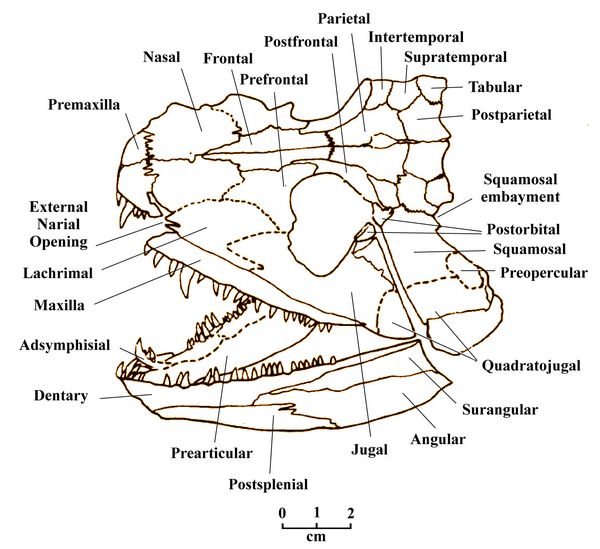Athena Review Image Archive ™
Whatcheeria deltae skull

Skull of Whatcheeria deltae (after Lombard and Bolt 1995).
Whatcheeria deltae was a primitive tetrapod from the Mississippian period (340 mya), found in Delta Quarry, Iowa by M.P. McAdams. The genus is named after What Cheer, Iowa, the home town of the discoverer, while the species is named for the find site. W. deltae belongs to the phylum Chordata, the class Sarcopterygii (lobe-finned fish), the superclass Tetrapoda, and the family Whatcheeriidae
The holotype (FM PR 1871700, at the Field Museum of Natural History in Chicago) is a skull with presacral vertebral column, a partial shoulder girdle, ribs, and a partial hindlimb. Over 200 other tetrapods have also been recovered from the same site.
Whatcheeria shows a mixture of sarcoptygerian (lobe-finned fish-like) and tetrapod (early amphibian) traits. The skull retains a number of primitive characters, such as the preopercular bone, and some characters of the lower jaw, which are lost in later tetrapods. The skull is 200-250 mm long, with a large parietial foramen, a Meckelian foramen on the lower jaw, a cleithrum, and an array of large, recurved teeth.
The body length was 1 m. Expanded ribs found in the thoracic region of the trunk are somewhat reminiscent of those of Ichthyostega, and flattened, paddlelike limbs are reminiscent of both Ichthyostega and Acanthostega. Along with the limb bones are at least 5 digits.
References:
Clack, J. 2012. Gaining Ground .
Lombard; R.E. and J.R. Bolt; 1995. A New Primitive Tetrapod, Whatcheeria Deltae, from the Carboniferous of Iowa. Paleontology vol 38 (3); pp.471-494.;
:
Copyright © 1996-2020 Rust Family Foundation (All Rights Reserved).